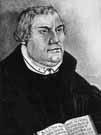
|
|
|

|

|

|

|
|
Click on an image to see a larger, more detailed picture.
|
|
|
|
|
| PROLOGUE: Roots of the Holocaust |

|
pg. 45 |

|
|
|
|
| |
 Martin Luther, founder of Protestantism in the 16th century, advocated "abandonment" of Jews who refused to convert.
Martin Luther, founder of Protestantism in the 16th century, advocated "abandonment" of Jews who refused to convert.
Photo: Bilderdienst SYddeutscher Verlag
|
|
In all of these places, Jews found ways to flourish and enhance the vitality of the regions they inhabited. But the Jews, always a minority people in these circumstances, lacked the power to control their own destinies. In particular, set apart from the Christian majority by their Jewish traditions, Jews in the European diaspora (scattering) often became the targets of suspicion, prejudice, hatred, and violence that the majority Christian population directed against them. Why that hostility existed can be understood further by noting that Christianity grew historically out of Jewish monotheism (worship of a single God) and the traditions of Judaism as they existed nearly 2000 years ago. Although Jesus of Nazareth came to be understood as the founding leader of Christianity, he did not intend to start a new religion. Jesus was a practicing Jew, and he died as one. His original followers were practicing Jews as well. In agreement with Jewish traditions, Jesus' teachings emphasized love of one's neighbor, the need for repentance, and liberation for the oppressed. Although he rejected violence, Jesus suffered a violent death when Pontius Pilate, the cruel Roman governor of Palestine, took Jesus' execution as the most expedient way to stop the political upheaval that Jesus and his followers might cause.
|
 The World That Was Lost
The World That Was Lost
Approximately nine million Jews lived in the many European countries that Nazi Germany would occupy during World War II. All of them were eventually targeted for death--not for anything they had done, but simply because they were Jewish. In 1933 German Jews numbered about a half-million, less than one percent of Germany's population. Like the Jews in other Western European nations, German Jews often adopted the culture, but not the religion, of their non-Jewish neighbors. Thousands of Jews had served in the German Army during World War I. Many were decorated for bravery. From 1905 to 1933, Jews won 11 of the 37 Nobel Prizes awarded to Germans. The largest Jewish population was in Eastern Europe (pictured), where many lived in predominantly Jewish towns called shtetls. These Jews were less assimilated than those in Western Europe. Yiddish--a mixture of German, Hebrew, and Slavic languages--was usually spoken, and Orthodox religious observance was the norm. In many places, Jews had their own schools, libraries, banks, athletic and cultural organizations, and a variety of political groups. In spite of antisemitism, European Jews maintained their traditions, sustained a vital cultural and religious life, and contributed impressively to Western civilization wherever they lived.
Photo: Bilderdienst SYddeutscher Verlag
|
|

|

|

|

|
 1927: Seventy-seven percent of university students in Prussia--feeling threatened by Jewish intellectual and commercial accomplishments--demand an "Aryan paragraph" that will exclude Jews from organizations, federations, parties, and eventually all public life.
1927: Seventy-seven percent of university students in Prussia--feeling threatened by Jewish intellectual and commercial accomplishments--demand an "Aryan paragraph" that will exclude Jews from organizations, federations, parties, and eventually all public life.
|
 March 10, 1927: Germany's Weimar government lifts its speaking ban on Hitler.
March 10, 1927: Germany's Weimar government lifts its speaking ban on Hitler.
|
 May 2, 1927: The U.S. Supreme Court rules in Buck v. Bell that compulsory sterilization is constitutional.
May 2, 1927: The U.S. Supreme Court rules in Buck v. Bell that compulsory sterilization is constitutional.
|
 July 4, 1927: Joseph Goebbels publishes the first issue of the antisemitic Der Angriff (The Attack). It is founded to rally Nazi Party members during the nearly two-year ban on the Party in Berlin.
July 4, 1927: Joseph Goebbels publishes the first issue of the antisemitic Der Angriff (The Attack). It is founded to rally Nazi Party members during the nearly two-year ban on the Party in Berlin.
|
 1928: The Kaiser Wilhelm Institute for Anthropology, Human Genetics, and Eugenics is established in Germany.
1928: The Kaiser Wilhelm Institute for Anthropology, Human Genetics, and Eugenics is established in Germany.
|
|
|
|
|
| PROLOGUE: Roots of the Holocaust |

|
pg. 45 |

|
|
The Holocaust Chronicle
© 2009 Publications International, Ltd.
|
|
